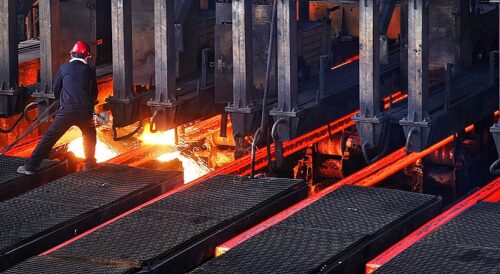>>REAL-TIME UPDATES IN THE WIRE. CLICK HERE<<<
China’s steel production continued to decline in August due to sluggish market demand and the impact of the power rationing.
In the past few months, Chinese steel mills have been cutting production to reduce losses amid weak demand and falling steel prices. According to data from the National Bureau of Statistics, China’s output of crude steel, pig iron and steel products fell by 13.1%, 11.3% and 13.2%, respectively, in July from the previous month.
In particular, the average daily crude steel output hit 2.63 million tonnes in July, marking the lowest level in three years and sliding 13.1% from the prior month, showed the data.
The production cut came after steelmakers reported weaker earnings so far this year. As of August 26, 33 publicly listed Chinese steelmakers have released first-half earnings, among which 24 firms saw net profit decline year on year. Liuzhou Iron And Steel Co.Ltd reported a net loss of 957 million yuan for the six-month period, compared to a net profit of 1.88 billion yuan during the same period last year, citing to rising raw material prices, sluggish real estate market, etc.
Into August, steel prices have shown some recovering signs, but the sector remains cautious. According to data compiled by steel industry information provider Zhaogang.com, 46 Chinese steelmakers were in maintenance or planning maintenance in August, affecting 773,400 tonnes of melted iron output, 555,500 tonnes of steel rebar output, 7,700 tonnes of wire rod production and 970,100 tonnes of hot-rolled coil production etc.
In particular, due to extremely high temperature and power rationing in several provinces including Zhejiang, Jiangsu, Anhui, Sichuan and Chongqing city, industrial companies have been told to adopt off-peak production mode, with many steelmakers forced to shorten production or even suspend production.
“Electric furnaces steelmakers’ operating rate has slid for three consecutive weeks since August 3, decreasing by 12.12% during the three weeks,” according to data from Zhaogang.com
Sichuan province has been the most severely affected and the 11 electric furnaces steelmakers in the provinces all told to suspend production, which may affect 210,000 tonnes of steel production, said analysts from Zhaogang.com.
China has been reducing crude output in recent years to help achieve its carbon-peaking and carbon-neutrality targets and the authorities had earlier said that steel production cut would continue this year.
He Shaoling, senior analyst at Zhaogang, said that China’s crude steel in the first seven months of the year declined by 40 million tonnes from a year earlier and output in the next few month may recover slightly amid easing pressure for production cut, falling inventories and slighly recovering demand. For the whole of 2022, China’s crude steel output will likely decline by 15 – 30 million tonnes from the previous year, He said.
In the first ten days of August, social inventories of the five major steel products in China’s 21 major cities stood at 10.28 million tonnes, falling by 4.2% from the end of July and sliding 15.25 from a year earlier, according to data from the China Iron and Steel Association.
Steel products’ social inventories is a key factor to watch and although the inventories have declined for ten consecutive weeks, it’s not driven by recovering demand, but mainly due to insufficient market confidence and a lack of funding in downstream companies, said Wang Guoqing, director at research center of consultancy Lange Steel.
As the policy for ensuring property deliveries, stepped up infrastructure investment and the end of high temperature, construction activities may pick up and steel demand will likely see some recovery, said Wang.
He Shaoling noted that, performance of the infrastructure, new energy and automobile industries remains good, but their steel consumption only accounts for 16% – 17% of the total, while the real estate sector’s steel consumption accounts fro 35% – 36% of China’s total steel consumption, therefore in the increase of steel demand in the infrastructure sector may not be able to offset the drop in the real estate sector.
Given the global inflationary pressure and economic recession, China’s domestic steel prices are likely to remain in a downtrend in the period of September – December, but due to falling supply and slight recover in domestic demand, steel market may see rebalancing in the third quarter and temporary rebound, said He.

